https://vimeo.com/1038401163 Welcome back to our weekly update. Another Friday the 13th? Oooph. I hope everyone gets through the day without any black cats, walking under ladders, you know the drill. What are you superstitious about? We hope you have a great day, nonetheless. On this update, we’ll talk heat pump water heaters, the effects of Read more
Featured Articles

Welcome back to our weekly update. Another Friday the 13th? Oooph. I hope everyone gets through the day without any black cats, walking under ladders, you know the drill. What are you superstitious about? We hope you have a great day, nonetheless. On this update, we’ll talk heat pump water heaters, the effects of potential tariffs from the new president, and our new podcasts.

There has been some tough rhetoric coming out of president-elect Trump’s camp regarding tightening the screws on imported goods by implementing a hefty tariff on countries such as China, Mexico and Canada, to name a few. Is this a good attempt to bring more manufacturing stateside? How will this affect the economy? Is this even Read more
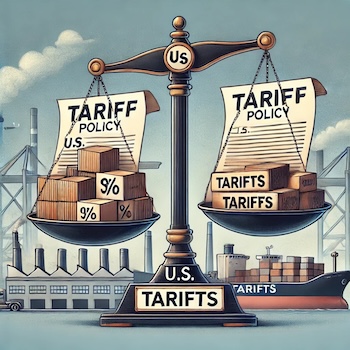 There has been some tough rhetoric coming out of president-elect Trump’s camp regarding tightening the screws on imported goods by implementing a hefty tariff on countries such as China, Mexico and Canada, to name a few. Is this a good attempt to bring more manufacturing stateside? How will this affect the economy? Is this even a good idea? We talk to some industry leaders about tariffs and what it means for the U.S. economy moving forward.
There has been some tough rhetoric coming out of president-elect Trump’s camp regarding tightening the screws on imported goods by implementing a hefty tariff on countries such as China, Mexico and Canada, to name a few. Is this a good attempt to bring more manufacturing stateside? How will this affect the economy? Is this even a good idea? We talk to some industry leaders about tariffs and what it means for the U.S. economy moving forward.
Recently, on the Crosstalk episode of the Make Trades Great Again and Appetite for Construction podcasts, this very topic came up and Andy Mickelson, Mickelson Plumbing and Heating, Missoula, Mont., and Eric Aune, Aune Plumbing, Zimmerman, Minn., were in unison in their view on tariffs. “There will be an impact,” says Mickelson. “Every single item that we touch has some impact from an imported product or good. And to sit back and believe that it’s not going to have a day-to-day impact or a cost increase is foolish.”
“It’s a tax that’s going to kill sales; it’s definitely going to affect us moving forward, especially if we see higher tariffs,” says Aune.
Mickelson continues, “There’s going to be a ‘trickle up’ effect, and along with that we’re going to see a lack of material … we saw brief chunk of this in 2021 when we had the port issues and shipping problems, and you extrapolate that into that into that these items aren’t coming because they are too expensive, how do you get around that? You can’t just flip a switch and just say we’re just going to make it here. We’re not ready for that, and I don’t think that this country is ready to become a manufacturing country. I don’t think there enough people who are willing to work on the assembly line … we can’t get people to sign up right now to become a plumber or an electrician or a data communication person—any of those manufacturing-type jobs are very much so in line with what it means to go out and work with your hands, be in a skilled trade.”
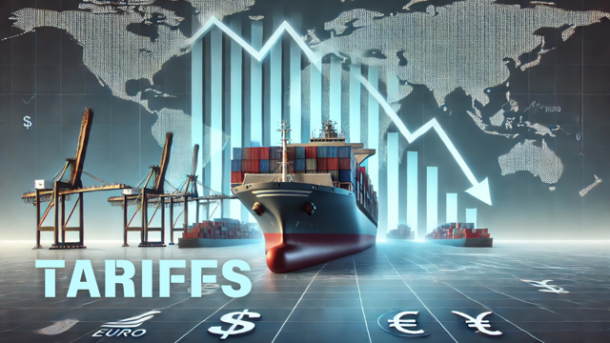
So, the back-and-forth debate continues to brew relating to whether instituting tariffs is beneficial to the American economy and the American worker. Dain Hansen, Executive Vice President, Government Relations, The IAPMO Group, says that economists have different views on the topic of tariffs, but the plumbing industry is well-positioned to support continued domestic production of what our country needs—and increase U.S. exports to other countries.
“Any policy that strengthens our manufacturing muscle is good for the economy and increases job opportunities in the trades. Programs such as the Market Development Cooperator Program and Standards Alliance at USAID, along with the Department of Commerce’s Foreign Commercial Service, provide vital support to U.S. exporters. We hope the administration will continue backing these programs to ensure U.S. products remain competitive overseas. We continue to monitor the impact tariffs are having on our global industry as manufacturing move locations to avoid these costs,” says Hansen.
While IAPMO is cautiously optimistic and vigilant, Plumbing Manufacturers International (PMI) shares concern. “During his campaign, President Trump spoke about his desire to increase tariffs—as high as 60% on Chinese goods, 10% to 20% across the board on all foreign goods, including Europe, and 25% on imports from Mexico, unless they curb the number of immigrants coming across the border. If he’s successful, these tariffs will have an inflationary impact, increasing the costs of production and in turn the costs of products in the marketplace. That’s certainly one of the biggest concerns plumbing manufacturers have right now.
“Our stance on this issue all along is that tariffs are harmful to the economy because they increase costs for manufacturers and have an inflationary impact on customers wishing to purchase plumbing products. These increased costs lead manufacturers to provide fewer jobs and they have less money for compensation as well. From an economic standpoint, we see no benefits from tariffs. PMI has always been an advocate for free and fair trade among nations,” says Kerry Stackpole, CEO and Executive Director, PMI.
According to Ben Brubeck, Vice President of Regulatory Labor and State Affairs, Associated Builders and Contractors (ABC), tariffs are a negotiating tool to renegotiate policies with other countries. “While having a hard time getting materials from overseas, resolving the domestic supply chain is a good thing.”

https://youtu.be/m_DO55cyhKk?si=rUvfAflAErmiaS5M Eric’s been busy on the road performing his magic by providing heat for his customers. In this case, he travels to Sterling, Ill. to install a new radiant heating system for friend Kyle Stumpenhorst @rrbuildings on Instagram, who features work on post frame structures. This new radiant system should elevate the comfort and efficiency Read more
Eric’s been busy on the road performing his magic by providing heat for his customers. In this case, he travels to Sterling, Ill. to install a new radiant heating system for friend Kyle Stumpenhorst @rrbuildings on Instagram, who features work on post frame structures. This new radiant system should elevate the comfort and efficiency of his post frame building to the next level!

https://vimeo.com/1032700697 We hope everyone has a wonderful Thanksgiving and you are able to take some time to share it with family, friends and loved ones. This update is dedicated to some examples of those giving back. We’ll also tell you what’s cooking with our weekly podcasts as well Read more
We hope everyone has a wonderful Thanksgiving and you are able to take some time to share it with family, friends and loved ones. This update is dedicated to some examples of those giving back. We’ll also tell you what’s cooking with our weekly podcasts as well.

In the United States, there are three general types of electrical suppliers. They are: Investor-Owned Utilities (IOU) Municipally Owned Utilities (MUNI) Customer Owned Rural Cooperatives (Co-op) Investor-Owned Utilities include big names in Electrical & Natural Gas distribution such as Con Ed, Florida Power and Light, and Pacific Gas & Electric. These are investor-owned utilities. There Read more
In the United States, there are three general types of electrical suppliers. They are:
- Investor-Owned Utilities (IOU)
- Municipally Owned Utilities (MUNI)
- Customer Owned Rural Cooperatives (Co-op)
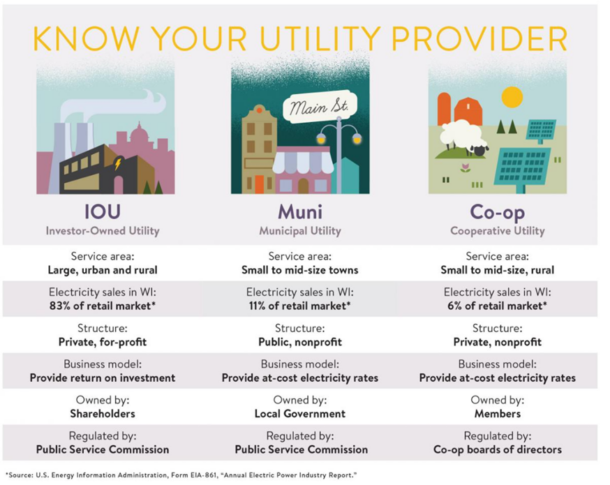
Investor-Owned Utilities include big names in Electrical & Natural Gas distribution such as Con Ed, Florida Power and Light, and Pacific Gas & Electric. These are investor-owned utilities. There are 168 IOUs in the US that serve about 110 million customers. They are regulated by their respective Public Service Commissions (PSCs) and must conform as a regulated monopoly.
Municipally Owned Utilities (there are 958 of them) include names like Rochester Public Utilities, Tampa Electric Company, and Philadelphia Gas Works. Since these utilities are owned by a municipality or another government agency, they are regulated by their owners, meaning the city or community.
Customer Owned Rural Cooperatives (there are 832 of them) include names like Texas-based Pedernales Electric Cooperative, The Nebraska Rural Electric Association, and New Jersey’s Sussex Rural Electric Cooperative. These utilities exist to bring the best services possible to their consumers, and they are run by the folks that pay also pay for the energy.
Investor-owned electric utilities are typically regulated and operate as vertically integrated monopolies with oversight from public utility commissions. They may operate in deregulated markets in which electric energy prices are set by the market and are subject to federal oversight of their wholesale market.
Before 1990, most investor-owned electric utilities were regulated and vertically integrated. That means that the utilities own electricity generators and power lines (both distribution and transmission lines). Presently about 30% of US electricity demand is serviced by these fully integrated utility markets. In much of the US, states have abandoned this system in favor of deregulation.
In traditionally regulated regions, utilities operate as a monopoly in their territories. That means that customers only have the option to buy power from them. To keep electricity rates reasonable, state regulators oversee these electric utilities and set electricity prices. Retail electricity prices are set based on the utility’s operating and investment costs alongside a fair rate of return, which is called a “revenue requirement”. This revenue is approved by the state’s public utilities commission and prevents utilities from overcharging customers for energy.
Smaller rural electric cooperatives power 56% of the American landscape, serving 42,000,000 residents, including 92% of impoverished counties.
There has been tremendous publicity for geothermal technologies. Direct use and enhanced geothermal systems are providing incredible baseload electricity and thermal energy for infrastructure. Geothermal technologies are strategically vital toward management of peak demand on the grid. The wide-spread power outages in Texas (2021) are an example of a runaway peak demand in the heating season.
“Ground Source Heat Pumps (GSHPs) are the key to managing demand on the electrical grid.”
With the high demand for air conditioning in the summertime, why would a wintertime freeze cause the electrical grid to “spike” as we saw in Texas in 2021? Most people know that air conditioning loads in the middle of August usually drive the greatest demand on the grid. However, electric heaters & air source heat pumps (ASHPs) are often used to handle peak heating loads, and they can double or triple that peak demand in the wintertime, when compared with summertime demand. Here’s a primer on how and why that is:

Energy Facts:
- 1 watt of electricity = 3.412 BTUs
- I kW of heat consumed by an electric heater = 3,412 BTUs of heat output
- I kW of heat consumed by an electric Geothermal Heat Pump (GHP) = 17,060 BTUs of heat*
- It takes 20% the kW to do the same heating with a GHP *(@5.0COP)
As it gets colder outside, Air Source Heat Pumps (ASHPs) must work harder to extract heat from the air. Geothermal Heat Pumps (GHPs) continue to have high efficiency operation regardless of outdoor temperature (because underground temps are reasonably stable).
Cold temperatures can reduce the efficiency of heat pumps, simply because it’s hard to extract heat from outside air as it gets colder. The efficiency of ASHPs drops as it gets colder outside, just as the gas mileage efficiency of a car drops when it’s climbing a hill. Geothermal heat pumps are not normally subject to drastic temperature fluctuations, because they’re coupled with the temperature in the shallow earth, which ranges between about 45 and 75 degrees in the US.
There have been a few Customer-Owned Rural Cooperatives (Co-ops) in recent decades that have been able to capitalize on reduced demand in summer, and increased revenue from electric GHPs in the winter. Look at the demand of two identical office buildings in Oklahoma. One has air-source heat pumps (ASHPs), the other, geothermal heat pumps (GHPs):
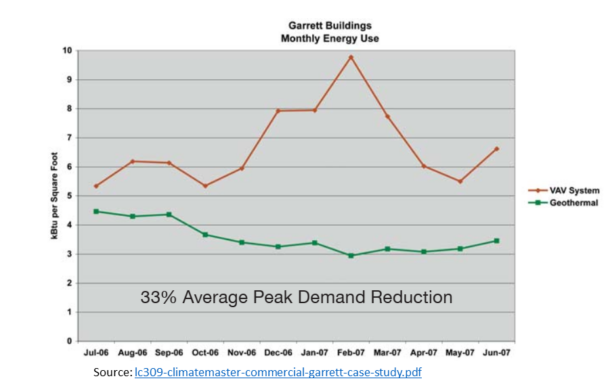
It’s obvious that there is a demand reduction in the summer, but the winter savings & peak demand reduction are remarkable. Here are some figures from Boyd Lee, an employee of CKenergy in Oklahoma:
- 2000 new GHPs replaced (both new construction and replacing gas furnaces)
- 4800kW Demand Reduction = $835,000/year.
- New sales totaled an additional 2,600,000 kWh, or about $260,000.
- Net annual increased revenue = $1,095,200.
What this means is that the electrical cooperative has more than $500 per year per home in additional income by going with a geothermal solution when compared to air sourced heat pumps. Electrical utilities typically look for payback in 60 years or less for infrastructure improvements such as power plants or distribution lines. Using that same logic, the utility has $30,000 per home to pay for the upgrades. That will more than cover the cost of the geothermal solution. And while ASHPs last 10 to 15 years, the GHP will last closer to 30 years because it can be installed all-indoors, and has a more stable heat exchange source, meaning it has much better working conditions.
Geothermal Exchangers Extract Energy from the Earth
The geothermal heat pump solution in the CKenergy case totaled 5142 Tons of capacity, and reduced demand by 0.65 kW per ton. That represents a 3.4 MW peak energy generation by the geothermal exchangers in the CKenergy case. Note that they see the geothermal exchangers as a source of energy, producing 3.4 MWs, removing that electrical load from the grid.
 Energy Poverty
Energy Poverty
1 in 4 households served by electric co-ops have an annual income below $35,000. Electric co-ops delivered 4.8% more electricity in 2022 than in the previous year.
Unlike the rest of the electric sector, electric co-ops sell most of their power — 53% — to households. Keeping rates affordable is especially important for these consumers at the end of the line. -NRECA analysis U.S. average annual residential electricity bill: $1,644
Electrical co-ops are perfectly poised to create demand side management (DSM) program setting include deep subsidies for geothermal heat pump (GHP) installations. The numbers seem to bear out a model that could allow the Co-op to pay for the entire ground loop exchanger and offer “on bill financing” for the GHP, electrical, and distribution upgrades needed. With 92% of persistently impoverished communities paying energy bills to electrical cooperatives, these are the folks that could truly benefit with some relief from high energy costs. The cure to energy poverty can be partially met through this demand side management since their energy bills will be drastically reduced with GHPs.
What’s next? We will see electrical co-ops begin to take advantage of this remarkable opportunity, and millions of geothermal heat pumps will be installed over the next 20 years in cooperative communities. As these cooperatives begin to understand the demand side value of GHP’s, they will embrace the opportunity to utilize the energy source that is the earth for heating and cooling within their service areas.
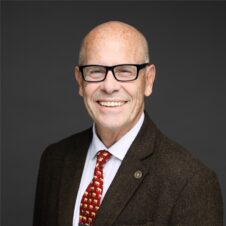 Jay Egg is a geothermal consultant, speaker, writer, and the owner of Egg Geo. He has co-authored two textbooks on geothermal HVAC systems published by McGraw-Hill Professional. He can be reached at jaye@egggeo.com.
Jay Egg is a geothermal consultant, speaker, writer, and the owner of Egg Geo. He has co-authored two textbooks on geothermal HVAC systems published by McGraw-Hill Professional. He can be reached at jaye@egggeo.com.
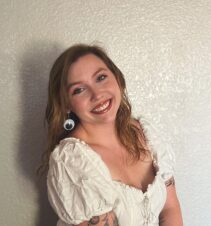 Mimi Egg is a social media marketing professional, writer and media technical consultant for Egg Geo, focused on building online connections and educating on social media platforms. Her desire to educate the rising generation about green, sustainable living is a major focus in her career. Egg may be reached at mimieggshell@gmail.com
Mimi Egg is a social media marketing professional, writer and media technical consultant for Egg Geo, focused on building online connections and educating on social media platforms. Her desire to educate the rising generation about green, sustainable living is a major focus in her career. Egg may be reached at mimieggshell@gmail.com

 Energy Poverty
Energy Poverty